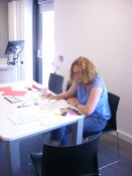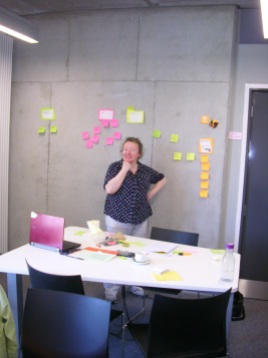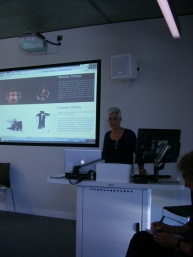A bit more than two years ago, Fiona English and myself were asked by Julia Lockheart, the editor of the Journal of Writing in Creative Practice, whether we would be interested in guest editing a Special Issue on Genre and Regenring for that publication. A themed workshop and conference, as well as months of editing work later, not one, but two issues are now published (Volume 11: Numbers 1 and 2), by us jokingly referred to as the Chicken and the Egg issue respectively.
This seemed like a good point for us two co-guest-editors to reflect on the process, so here a conversation that we had one September morning, in case you are interested in our thoughts on the process, the idea of using two different forms of editorial (one traditional, one as an abecedary) and whether we would change anything.
Find out more about Issue 1 (the Chicken) here.
Find out more about Issue 2 (the Egg) here.
(This was a typed chat, and I have tried to get rid of typos but have not changed grammar or structure of the unscripted exchange.)
Alke: So, the two issues are out and I thought it would just be a nice idea if we reflect on what worked and what didn’t. Do you think we achieved what we wanted to do?
Fiona: I’m actually really proud of these two issues. The range and quality of the articles is fantastic – so interesting to read and so well written. The production side too is great. They look and feel good in the hand.
Alke: I agree, as the physical things, the journals worked out really well. Now for me this was one of the surprising things – that I always thought of the journals as a physical entity, but that is not how the publisher saw them, they see them as separate articles… that took me a while to realise. If we had thought about them like this, would we have done anything differently, do you think?
Fiona: Yes I know what you mean. The on-line article as stand-alone access makes the experience quite different. I don’t think we would have done anything differently in this particular case nor do I think we should have. The flow of the physical versions works really well and hopefully people will actually get to see this. However, if we do another thing like this we might think about it differently and provide a different kind of threading to preface each article. Maybe that’s something we could do in any case? If the publisher let us.
Alke: I’m not sure we should volunteer any more work on this, to be honest 😉 And I really like them as a collection – I think this is where the value of this lies, to see the different ways of using genre side by side, in a way. I seem to remember that one of the things we wanted to do at the beginning was give people the confidence to try out more and to take more ownership (shouting about?) the practice they were already doing, almost giving them a theory to be able to justify their playing with genre as a ‘serious’ thing – and I think that this collection does show that off, and hopefully does that.
Fiona: I agree – and I’m certain this has been achieved. I’m glad we pushed some people to write differently while leaving others to their own devices. It means that we have a range of genres which then means that readers can consider the affordances of each as they read. What do you think about setting up a kind of feedback forum? Getting readers’ responses to the different articles with regard to how the genres used impacted on their reading and on their attitude to the ‘knowledge’ being explored/developed.
Alke: I think that would be really interesting – maybe I could ask for that at the end of this blog post and also ask the contributors to add to.
Fiona: Yes great. It could also comprise an element of any seminar/party we might plan for the future.
Alke: I love it! A feedback party instead of a launch!
Fiona: It would be good to get feedback on people’s own attitudes to alternative genres for academic production and how they might be valid in the context of REF!!! And yes, a feedback party –
Alke: I think we might have found our angle for the follow-up event! Now, we also played with genre, not just in our own, separate contributions, but in the two editorials… which in a way are very different…
Fiona: Yes I’ve been thinking of the differences in experience doing them. The essential difference in terms of process is that one is a kind of narrative – it tells a story in a chronological order so to speak. The second works as a kind of glossary – explanation of terms of ref or rather concepts that are explored across the issues – and as such required a different kind of thinking – explanations and definitions rather than narrative. We had to say more about our frames of reference in the second one and more about the journal as a flow in the first. Is that right?
Alke: In a way, yes. I have to admit that I (maybe naively) had thought that the abecedary would be so much easier to do as a format than it actually was. In the end figuring out what to include and what not, and having the constraints of the alphabet was a really interesting challenge!
Fiona: the abecedary was a challenge for sure – but a very interesting one as it forced us to foreground concepts and key issues and to use the alphabetic constraints to think of fresh ways for describing/defining them. In other words, the affordances of each genre ensured that we approached the same information differently and in the process of so doing produced different ways of articulating it. This made us rethink – always a good thing.
Alke:: Exactly. And I am really glad that we decided on taking on that challenge rather than going for something like a conversation (which we had also considered), especially because it made us think about the content more in terms of definitions, rather than just rehashing the narrative in a two-person narrative way!
Fiona: Yes – that’s very true. And it was fun too! Playing around trying to find a way of using all the letters – only one cheat with the X.
Alke: Thinking about it, I think we could have made ‘xerography’ work… the idea of copying stuff, or not, would have worked int the context of gains and losses!
Fiona: xerography – yeah – but then we’d not have had ‘eXpectations’ – though we’d probably have squeezed that in elsewhere. Gains and Losses – yes – that’s true. What do you think these were between the two editorials?
Alke: Well, the first editorial gives much more background info as to how these issues came about, while the abecedary only really mentions the workshop and conference in passing. But they were both really important events. And, as you say, the second one is much more about definitions, being clear about what we are talking about and mean, which is easy to gloss over in a way when you are writing a narrative.
Fiona: Yes I agree. The first one tells the story of how things came about and why and how the journal is organised. It makes an easier read, probably, as a whole because it does what people expect despite the informal tone we use. It is also more effective in profiling the different articles because they are introduced within a narrative structure. This is the story of how we got together and this is the story of how we got the contributions for these special issues and this is the story of how the issues have been organised. The Issue One editorial had to go first – the chicken before the egg otherwise readers would have been totally confused.
Alke: LOL
Fiona: t’ll be interesting to get feedback from the readers/contributors of Issue Two about how they feel about the editorial. They won’t have seen the first one.
Alke: That’s a really good point! I hadn’t even considered that!
Fiona: No nor had I until we started this discussion. (the affordances of a dialogic genre 😉
Alke: 🙂 Would we change it if we had to do it again? Or better: is there anything we would change?
Fiona: That’s a good question. Did we point out in the Egg that we had done a different kind of editorial for the Chicken? I can’t remember. I think we saw them as two sides of the same coin and forgot that not everyone would read everything. Again, back to the thing about single article purchases too!
Alke: let me just check…We do mention it under ‘A is for abstract’ – sort of. Phew!
Fiona: That’s lucky – or rather not lucky – we took it into account. It’s amazing how quickly one (I, that is) forgets what one’s done almost as soon as you turn over onto the next page! I constantly have to keep checking back in things I’ve written to see what I said about something.
Alke: Well, I guess that comes with doing a lot of things. And once they are published, on file, so to speak, you don’t need to keep the details in your head, because you can just check back. but I think it is a really interesting point, that we didn’t just conceive this as a physical journal, but as a double issue, and didn’t really ever saw them as split up!
Fiona: That’s right!
Alke: maybe that means we misjudged our audience?
Fiona: Hum – yes perhaps. Not our audience exactly, but how our audience might read. This is food for thought. What we did with these two Issues could never be done via the on-line single purchase approach. We thought of these issues as if they were a book – a complete thing. That’s indeed what they are. The market forces behind the publishers, though, see/treat everything as stand-alone. It’s the same with modular university degrees. The idea that there is no need for an overall view/story but that things can just exist – contextless and floating out alone. In fact, the publisher’s approach militates against special issues!
Alke: I think you are right. In the book I just wrote they asked for each chapter to have its own separate bibliography so that the chapters could be sold separately (we decided to ignore that request for now…), but that changes the whole argument you can make and splits it into bite-sized chunks.Some things you want to say are bigger than that!
Fiona: Absolutely – this is a problem indeed and one which, in my view, leads to people picking up fag ends as the saying goes. In other words, piecemeal knowledge – knowledge with no context – in other words, not knowledge!
Alke: In fact, I think if at the beginning of this process somebody had told me to edit a collection of separate but related journal articles, I don’t think I would have been up for that! It is that context that makes it interesting and useful!
Fiona: Me neither. The whole pleasure of it was to put together a unified piece of work not lots of separate pieces of work.
Alke: So hopefully people will read both issues and not just pick out the odd article!
Fiona: I do hope so.
Alke: Anyway, anything else we would change?
Fiona: I don’t think so. For me the contributors have done a fantastic job in honing their articles not just in terms of academic content but in style and voice more so than in most other journal articles. I think they also saw themselves as working as part of a whole too. I mean they understood what they were writing to be a contribution to an overall story too. I think we got the range and balance right too across each issue.
Alke: Yes, I agree. I wouldn’t change the content. However – and this totally shows my roots as a designer – if I had realised how easy it was to change the cover image, I would have asked for two different ones: one of the furoshiki laid out, so you could see it whole, and one of it wrapped up, rather than combining those two ‘states’ into one image. but then maybe that would have put too much focus on that one artefact? Anyway, just a tiny thing with hindsight 😉
Fiona: Yes – that would have been good. And I don’t think it would have put too much onto the one piece. I think it would have perfectly represented regenring. But tant pis! They are still beautiful objects these two issues.
Find out more about Issue 1 (the Chicken) here.
Find out more about Issue 2 (the Egg) here.
If you have read both, one or just parts of these special issues, please comment on this post with some feedback about the above topics or others!



































